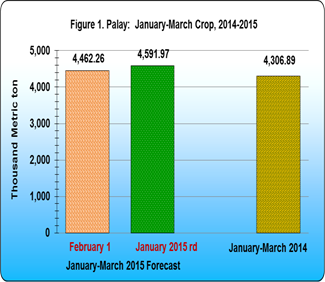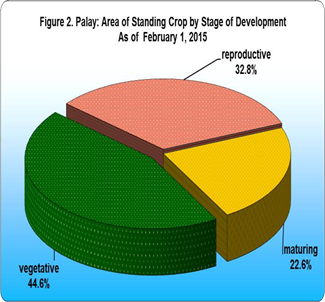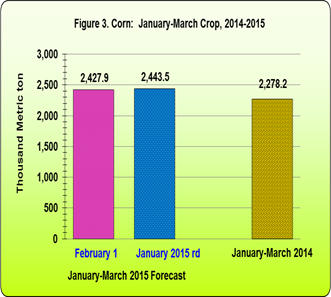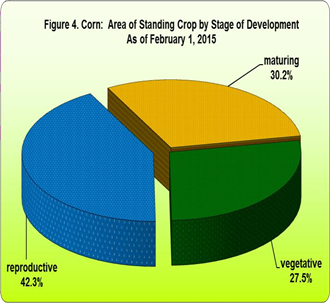Release Date :
Highlights
As of February 1, 2015, the updated January-March 2015 forecasts on palay and corn standing crops may decrease compared with the January 2015 Round forecasts. The decline could be attributed to contraction of harvest areas and drop in yield due to the adverse effects of typhoons “Seniang” and “Amang”, intense heat, insufficient water supply, incidence of pests and diseases, and lodging caused by strong winds in some provinces.
PALAY
- Palay production for January-March 2015 may reach 4.46 million MT, 2.8% lower than the January 2015 round forecast of 4.59 million MT but 3.6% higher than last year’s output of 4.31 million MT. Harvest area may contract from 1.17 million hectares to 1.16 million hectares. Yield may drop from 3.93 MT per hectare to 3.84 MT per hectare.

- Contraction in harvest area and drop in yield could be the result of damages brought about by typhoons “Seniang” in Capiz and Negros Occidental last December 2014 and “Amang” in Camarines Sur last January 2015.
- In Iloilo, Tarlac, Mindoro Oriental and Cagayan, the insufficient water supply and intense heat during the vegetative and reproductive stages of palay may reduce the yield.
- The incidence of stemborer and rice black bug in Sultan Kudarat, South Cotabato, Maguindanao, Cavite and Laguna may contribute to lower production. Other factors such as lodging due to strong winds during the reproductive stage of the crop may bring about reductions in yield in Quezon, Laguna, Antique and Zambales.
- Around 241 thousand hectares of the updated standing crop have been harvested. About 683 thousand hectares or 73.5% of the planting intentions for the April-June 2015 crop have been realized.
- Of the 1.60 million hectares standing palay crop, 44.6% were at vegetative stage; 32.8%, at reproductive stage and 22.6%, at maturing stage.

CORN
- Corn production for the first quarter of 2015 may reach 2.43 million MT. This was 0.6% below the earlier forecast of 2.44 million MT but 6.6% above last year’s level of 2.28 million MT. Harvest area may decline by 0.61 thousand hectares, from 719.78 thousand hectares to 719.17 thousand hectares. Yield may drop to 3.38 MT per hectare from 3.39 MT per hectare.

- The probable decrease in corn output could be attributed to insufficient water supply, late onset of rainfall and intense heat in Tarlac, Batangas, Maguindanao, Sultan Kudarat and Cavite.
- Contraction in harvest area and lower yield could be due to the adverse effects of typhoons “Seniang” and “Amang” in Camarines Sur, Capiz, Cebu and Misamis Oriental.
- In South Cotabato and Batangas, the expected decrease in output could be due to lodging caused by strong winds. In North Cotabato, the decrease in output could be due to flashfloods.
- About 205 thousand hectares of the updated standing crop have been harvested. Around 206 thousand hectares or 51.1% of the planting intentions for the April-June 2015 harvests have materialized.
- Of the updated 720 thousand hectares of standing corn crop, about 27.5% were at vegetative stage; 42.3%, at reproductive stage and 30.2%, at maturing stage.

